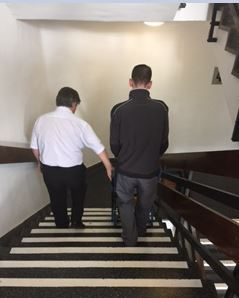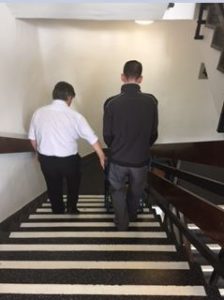



For someone in an organization who’s in charge of health & safety, it’s important to have a plan for fire evacuation. We asked Ian Thompson (sales & marketing director of EVAC+CHAIR International) and our main evacuation specialist manufacturers, what his thoughts are when considering evacuation from multi-story buildings.
He advised that;
1. Firstly you need to consider that it’s everybody’s responsibility
Contrary to public belief, it’s NOT the fire services responsibility to evacuate a building in an emergency. This falls on the employer’s or service provider’s shoulders.
Anyone who requires to be evacuated (and this is NOT just the permanently disabled) must be considered in a company’s fire evacuation plan, and more importantly, if the company neglect to prepare properly for any mobility-impaired persons evacuation, they could be found guilty of failing to provide a duty of care which can carry a custodial jail sentence under the Health & Safety Offences Act.
2. Who’s been trained to use the equipment?
Evacuation chairs cannot just sit on a wall for years, then someone is designated to use them when there’s an evacuation. Teams of evacuation equipment operators, or at least designated persons should be evacuation chair trained by a reputable company who knows the equipment inside out, its’ characteristics, limits and operational limitations. It’s also surprising how many people are trained and don’t practice using the chairs during evacuation drills – at least every 6 months is the recommendation.
3 Importance of a Personal Emergency Evacuation Plan (PEEP)
A relevant person in your organization is responsible for ensuring those with mobility impairments (howsoever caused) have their own PEEP, or if you don’t have anyone at this time, you may just need a General Emergency Evacuation Plan (or GEEP).
So what sort of Questions regarding a person’s PEEP needs to be answered?:
These are all considerations that need to be addressed BEFORE THE EVENT, to avoid anxiety or concern during an actual event.
4. Test, test, test
There’s no substitute for practice and all staff, including the person who has a PEEP written and devised for their benefit, should regularly ensure that the plan will work. Remember the PEEP should not just be written and stored away. Staff involved in the evacuation, along with the person to be evacuated, should have a copy of the PEEP plan. The plan should be tested in regular drills, to ensure all staff involved are aware of the procedures. It’s probable that in a public building a PEEP wouldn’t be appropriate, so a GEEP is more likely to be required for all eventualities.
5. Consider the vulnerable?
EVAC CHAIRS and other devices have proved to be the most efficient and user-friendly, enabling chair operators and their passenger to safely exit the building. Consideration must be afforded to the possibility that more than one person may require assistance though, and other types of evacuation devices, such as slide sheets, rescue mats or stretchers may be needed in addition to evacuation chairs.
All devices required in the event of an evacuation must be located in a designated refuge point, specified in the buildings fire strategy. Each fire exit has to accommodate the able-bodied and mobility-impaired therefore all equipment has to be readily available.
Many thanks to Ian from EVAC+CHAIR for his valuable insight
For information about EVAC+CHAIRS, contact AED-DEFIB-SHOP on 0800 0431 327 for more information, or to purchase.

EVAC Chair users
Evacuation chairs are not only essential for stairway evacuation for those who are permanently disabled, But also for other vulnerable groups such as:
Our team of technical experts will teach you and your people how to use whatever type of stairway evacuation chair you invest in. Evac chairs are easy to use if staff are trained properly. The old chestnut about being dangerous and staff saying “you’ll not get me n one of these things” comes from lack of education and training, and is firmly against the reality of using an EVAC chair. That’s why our training is all about building confidence. Our comprehensive operator training courses for your EVAC operators, or Trainers (because we also carry out Train the Trainer courses to educate your staff in one day how to teach other key staff )

Still not sure which EVAC chair you’ll need. Give us a call. Our product specialists have plenty of knowledge and guidance to point you in the right direction.
We can even arrange a site visit to advise – Totally free of charge
Call us on 0800 0431 327